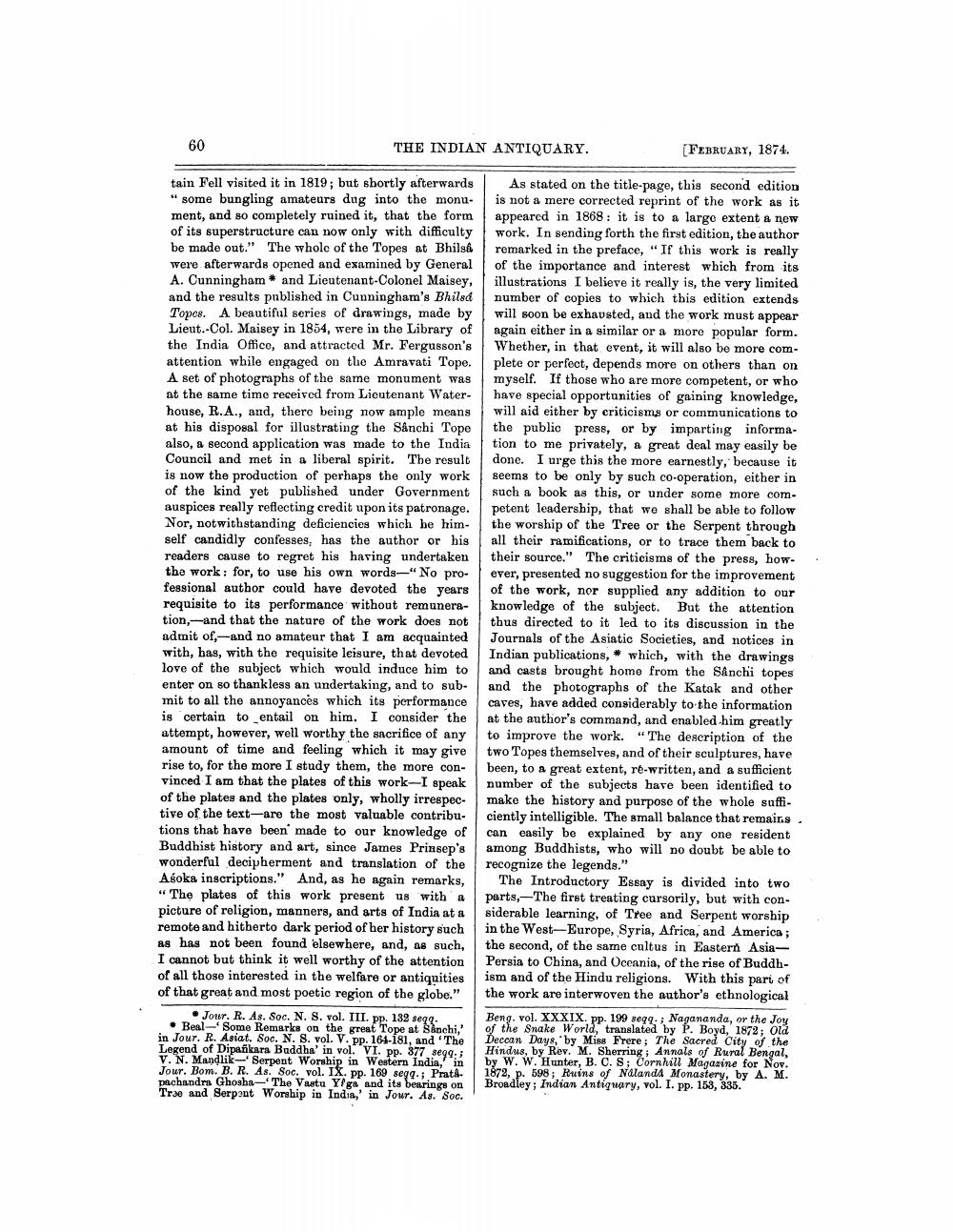________________
60
THE INDIAN ANTIQUARY.
[FEBRUARY, 1874.
tain Fell visited it in 1819; but shortly afterwards "some bungling amateurs dug into the monument, and so completely ruined it, that the form of its superstructure can now only with difficulty be made out." The whole of the Topes at Bhilsa were afterwards opened and examined by General A. Cunningham and Lieutenant-Colonel Maisey, and the results published in Cunningham's Bhilsa Topcs. A beautiful series of drawings, made by Lieut.-Col. Maisey in 1854, were in the Library of the India Office, and attracted Mr. Fergusson's attention while engaged on the Amravati Tope. A set of photographs of the same monument was at the same time received from Lieutenant Waterhouse, R.A., and, there being now ample means at his disposal for illustrating the Sanchi Tope also, a second application was made to the India Council and met in a liberal spirit. The result is now the production of perhaps the only work of the kind yet published under Government auspices really reflecting credit upon its patronage. Nor, notwithstanding deficiencies which he himself candidly confesses, has the author or his readers cause to regret his having undertaken the work : for, to use his own words—"No professional author could have devoted the years requisite to its performance without remuneration, and that the nature of the work does not admit of,--and no amateur that I am acquainted with, bas, with the requisite leisure, that devoted love of the subject which would induce him to enter on so thankless an undertaking, and to sub- mit to all the annoyances which its performance is certain to entail on him. I consider the attempt, however, well worthy the sacrifice of any amount of time and feeling which it may give rise to, for the more I study them, the more convinced I am that the plates of this work-I speak of the plates and the plates only, wholly irrespec- tive of the text-are the most valuable contributions that have been made to our knowledge of Buddhist history and art, since James Prinsep's wonderful decipherment and translation of the Asoka inscriptions." And, as he again remarks, "The plates of this work present us with a picture of religion, manners, and arts of India at a remote and hitherto dark period of her history such A has not been found elsewhere, and, as such, I cannot but think it well worthy of the attention of all those interested in the welfare or antiquities of that great and most poetic region of the globe."
As stated on the title-page, this second edition is not a mere corrected reprint of the work as it appeared in 1868: it is to a large extent a new work. In sending forth the first edition, the author remarked in the preface, "If this work is really of the importance and interest which from its illustrations I believe it really is, the very limited number of copies to which this edition extends will soon be exhausted, and the work must appear again either in a similar or a more popular form. Whether, in that event, it will also be more complete or perfect, depends more on others than on myself. If those who are more competent, or who have special opportunities of gaining knowledge, will aid either by criticisms or communications to the public press, or by imparting information to me privately, a great deal may easily be done. I urge this the more earnestly, because it seems to be only by such co-operation, either in such a book as this, or under some more competent leadership, that we shall be able to follow the worship of the Tree or the Serpent through all their ramifications, or to trace them back to their source." The criticisms of the press, how. ever, presented no suggestion for the improvement of the work, nor supplied any addition to our knowledge of the subject. But the attention thus directed to it led to its discussion in the Journals of the Asiatic Societies, and notices in Indian publications, * which, with the drawings and casts brought home from the Sånchi topes and the photographs of the Katak and other caves, have added considerably to the information at the author's command, and enabled him greatly to improve the work. "The description of the two Topes themselves, and of their sculptures, have been, to a great extent, re-written, and a sufficient number of the subjects have been identified to make the history and purpose of the whole soffi. ciently intelligible. The small balance that remains. can easily be explained by any one resident among Buddhists, who will no doubt be able to recognize the legends."
The Introductory Essay is divided into two parts -The first treating cursorily, but with considerable learning, of Tree and Serpent worship in the West-Europe, Syria, Africa, and America; the second, of the same cultus in Eastern AsiaPersia to China, and Oceania, of the rise of Buddhism and of the Hindu religions. With this part of the work are interwoven the author's ethnological Beng. vol. XXXIX. pp. 199 seqq.; Nagananda, or the Joy of the Snake World, translated by P. Boyd, 1872; Old Deccan Days, by Miss Frere; The Sacred City of the Hindus, by Rev. M. Sherring; Annals of Rural Bengal, by W. W. Hunter, B. C. S; Cornhill Magazine for Nov. 1872, p. 598; Ruins of Nalanda Monastery, by A. M. Broadley; Indian Antiquary, vol. I. pp. 153, 335.
Jour. R. As. Soc. N. S. vol. III. pp. 132 898. • Beal Some Remarks on the great Tope at Sanchi, in Jour. R. Asiat. Soc. N. S. vol. V. pp. 164-181, and 'The Legend of Dipafikara Buddha' in vol. VI. pp. 377 seqq.; V. N. Mandlik Serpent Worship in Western India, in Jour. Bom. B. R. As. Soc. vol. IX. pp. 169 seqq. Prats. pachandra Ghosha-The Vastu Yiga and its bearings on Trze and Serpent Worship in India,' in Jour. As. Soc.




